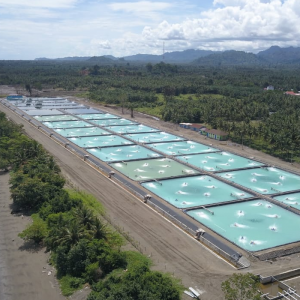
The Future of Fish Feed might be Fish-Free
| Wed, 11 Sep 2019 - 13:52
An Omega Protein fisherman looks down at a school of menhaden caught off the coast in Virginia. Atlantic menhaden are harvested as a nutritional supplement for human and animal consumption in oils, essential fatty acids and specialty protein. If you’re trying to be a conscious omnivore, chances are you’re putting some serious thought into the sustainability of the animal proteins you’re eating: Were the animals humanely raised, on farms/ranches that don’t harm the environment? The next level is to think about whether the feed itself of what we eat is sustainable. But even people concerned with GMO soy used for cattle might not be thinking about what their farmed salmon are eating.
Future of Fish Feed (F3) is trying to change that — at least in the aquaculture feed sector.
The X Prize of Aquaculture
F3 is a collaboration between nongovernmental organizations, scientists, and the private sector (backers include the University of Arizona, the New England Aquarium and the organizers of the X-Prize) to uncover new alternative feed ingredients for aquaculture that reduce or eliminate reliance on wild-caught fish. What’s wrong with fish eating fish? Well, in the case of farmed fish (hogs and poultry, too, but that’s another story), a large amount of feed for these animals relies on fishmeal and oils from small, wild-caught fish (aka “forage fish”) such as anchovies, sardines, and menhaden. And as aquaculture continues to boom — according to the Food and Agriculture Organization of the United Nations, aquaculture represented approximately 47% of global fish production in 2016 — the demand for fishmeal and fish oils to feed farmed fish is fast increasing.
That’s why just last week, F3 launched the third F3 Challenge, a contest that incentivizes global companies to develop and sell fish-free feed and oils for cash prizes. This year’s contest focuses on feed for carnivorous species such as salmon, shrimp, tuna, and cod, many of which rank as the most popular seafoods in the U.S. The first contest’s winner was Guangdong Evergreen Feed Industry Company, which was awarded a $201,000 prize by F3 for selling more than 85,000 metric tons of fish-free feed. According to F3, the amount of fish-free aquafeed (using plants, insects, algae and bacteria as a base) sold during the contest was roughly equivalent to 100 million forage fish from the ocean. The second contest, which ends Sept. 15, will award more than $100,000 to the company that develops and sells the most “fish-free fish oil.”
Scaling Up Fish-Free Feed
There are industry groups that challenge F3’s vision of a fish-free feed future, including the Marine Ingredients Organization (IFFO), which published a scathing rebuttal to the contest. And there’s bound to be concern down the road about whether these novel feed combinations might have unforeseen consequences. Still, the United States Department of Agriculture (USDA) and the National Oceanic and Atmospheric Administration have recognized the need for feed alternatives, as has the United Nations’ Food and Agriculture Organization (FAO).
Increased demand not only puts pressure on wild stocks of forage fish, it also has the potential to affect wild carnivorous fish that rely on forage fish for food (though some scientists refute this claim). According to a recent study in Nature Sustainability, if wild forage fish continue to be harvested as they are now, stocks could reach “ecological limits” by 2037, which means forage fish and all dependent aspects of the ecosystem could be in danger. There is a business case, too. While most forage fish fisheries are heavily regulated and aquaculture feed conversion ratios are improving, in recent years increased demand and variable supply has driven up the price of fishmeal and oils, which has aquaculture businesses on alert.
Fish-free innovations using algae, yeast, soy, and insect protein are all being tested with some success — and some challenges. The use of waste from fish processing in fishmeal is also becoming ever more efficient. While wild-harvested fishmeal and oil are unlikely to disappear from aquaculture feeds entirely, there’s room in the market for nutritious alternatives that don’t rely on wild marine resources.
Source : Forbes






















